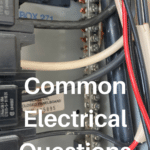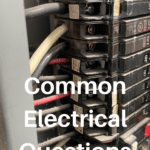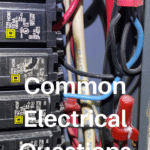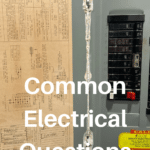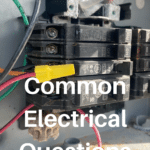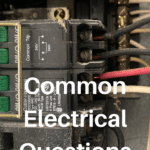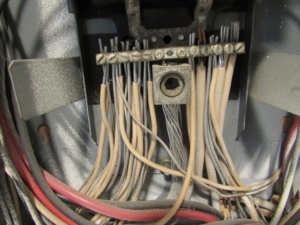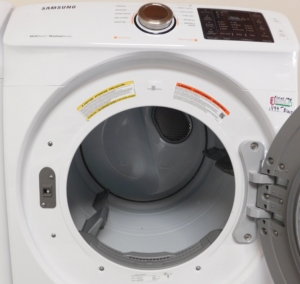Common Electrical Questions: Answers and Advice
Understanding the basics of electrical systems can often seem like a daunting task. With so many components, rules, and safety precautions, it’s easy to get overwhelmed. However, knowing the answers to some common electrical questions can help demystify the subject and make it more approachable.
No need to worry if you’re a beginner or even if you’ve been dabbling in DIY electrical work for some time. This blog post will answer some of the most common electrical questions you may have. From understanding electrical codes to knowing when it’s time to call a professional, this guide has got it covered.
Common Electrical Questions
Introduction
Why is my circuit breaker tripping?
A tripping circuit breaker can be a frustrating and concerning issue. However, it’s an important safety feature of your electrical system. Circuit breakers are designed to trip and shut off power when there’s an overload or a short circuit in your home’s electrical wiring. This helps prevent electrical fires and protects your home and appliances from damage.
If your circuit breaker is frequently tripping, it could be due to a few reasons:
- Overloaded circuit: Too many appliances or devices connected to a single circuit can overload it, causing the breaker to trip. To resolve this, redistribute the load by plugging devices into different circuits.
- Short circuit: A short circuit occurs when a hot wire comes into contact with a neutral wire or a ground wire. This can happen due to damaged or frayed wires. To fix this issue, it’s crucial to identify and repair the damaged wiring.
- Faulty electrical equipment: If a specific appliance or device consistently causes the circuit breaker to trip, it may be faulty and require repair or replacement.
If you’re unsure about the cause of your circuit breaker tripping, it’s best to consult a qualified electrician who can diagnose the problem and ensure your electrical system is safe.
How can I safely change a light bulb?
Changing a light bulb may seem like a simple task, but it’s essential to follow proper safety precautions to avoid accidents. Here’s a step-by-step guide on how to safely change a light bulb:
- Turn off the power: Before starting any work on a light fixture, make sure to turn off the power at the circuit breaker or by unscrewing the corresponding fuse.
- Allow the bulb to cool: If the light was recently on, give the bulb some time to cool down before attempting to remove it. Hot bulbs can cause burns.
- Remove the old bulb: Carefully twist the old bulb counterclockwise to remove it from the socket. If the bulb is stuck, try gently wiggling it back and forth while twisting.
- Insert the new bulb: Take the new bulb and carefully insert it into the socket, twisting it clockwise until it’s securely in place.
- Restore power: Once the new bulb is in place, restore power to the light fixture by turning on the circuit breaker or replacing the fuse.
What causes flickering lights?
Experiencing flickering lights can be annoying and may indicate an underlying electrical issue. Here are a few common causes of flickering lights:
- Loose connections: Loose connections in your electrical wiring or light fixtures can cause flickering lights. Check for loose connections and tighten them if necessary.
- Overloaded circuit: If multiple appliances or devices are connected to a single circuit, it can cause flickering lights. Distribute the load across different circuits to prevent overloading.
- Faulty light bulb: Flickering lights could be a result of a faulty light bulb. Try replacing the bulb to see if the issue persists.
- Voltage fluctuations: Fluctuations in voltage supply can cause lights to flicker. Contact your utility provider if you suspect voltage issues.
How do I know if my outlets are grounded?
Knowing whether your outlets are grounded is crucial for electrical safety. Here’s how you can determine if your outlets are properly grounded:
- Visual inspection: Look at the faceplate of your outlets. Grounded outlets typically have three holes – two vertical slots and a round hole, which is the ground pin.
- Outlet tester: Use an outlet tester, which is a small device with three prongs that you can plug into the outlet. The tester will indicate if the outlet is grounded or not.
- Consult a professional: If you’re uncertain about the grounding of your outlets or notice any issues, it’s recommended to consult a licensed electrician to inspect and ensure proper grounding.
Grounded outlets are necessary to protect you and your home from electrical shocks. If your outlets are not grounded, it’s essential to have them properly grounded by a qualified electrician.
What should I do if I experience an electrical shock?
Experiencing an electrical shock can be a frightening and potentially dangerous situation. Here’s what you should do if you find yourself in such a situation:
- Ensure your safety: If you can, quickly move away from the source of the electrical shock to avoid further harm. Do not touch the person or object experiencing the shock directly, as it may still be electrified.
- Cut off the power: If the electrical shock is caused by contact with an appliance or electrical device, turn off the power at the circuit breaker or unplug the device before attempting to help the person in distress.
- Call for help: Dial emergency services immediately or ask someone nearby to do so. Electrical shocks can cause injuries that require medical attention.
- Provide first aid if trained: If you have received proper training in administering first aid, check the person’s breathing and pulse. Perform CPR if necessary until medical professionals arrive.
How often should I replace my smoke detectors?
Smoke detectors play a vital role in keeping your home safe from fire hazards. To ensure their proper functioning, it’s important to know when to replace them. Here are some general guidelines:
- Battery-powered smoke detectors: Replace the batteries in your smoke detectors at least once a year. It’s a good practice to do this when you change your clocks for daylight saving time.
- Hardwired smoke detectors: Hardwired smoke detectors are connected to your home’s electrical system. They usually have a backup battery. Replace the backup battery once a year and follow the manufacturer’s recommendations for replacing the entire unit.
- Age of smoke detectors: Smoke detectors have a lifespan of around 10 years. After this period, they may no longer function properly and should be replaced.
Regularly test your smoke detectors by pressing the test button to ensure they are functioning correctly. If your smoke detectors emit a chirping sound or fail the test, it’s essential to replace them promptly to maintain a safe living environment.
What are the Answers to these Common Electrical Questions?
Electrical systems can sometimes be confusing, and it’s not uncommon to have questions about them. In this section, we’ll address some common electrical questions and provide you with clear and knowledgeable answers. Whether you’re dealing with a tripping circuit breaker, flickering lights, or grounded outlets, we’ve got you covered. Read on to find out everything you need to know!
Why is my circuit breaker tripping?
A tripping circuit breaker can be frustrating, but it actually serves an important purpose. When a circuit is overloaded or a short circuit occurs, the breaker automatically trips to prevent damage to your electrical system. The most common causes of a tripping circuit breaker include:
- Overloaded circuits: Plugging too many appliances or devices into a single circuit can overload it, causing the breaker to trip. To prevent this, distribute your electrical load evenly across different circuits.
- Short circuits: When a hot wire comes into direct contact with a neutral wire, a short circuit occurs. This can be caused by damaged insulation or faulty wiring. To fix this issue, you’ll need to identify the problem area and repair or replace the faulty wiring.
How can I safely change a light bulb?
Changing a light bulb may seem like a simple task, but it’s important to take some safety precautions. Follow these steps to safely change a light bulb:
- Turn off the light switch: Before changing a light bulb, make sure the switch is turned off to avoid any risk of electrical shock.
- Allow the bulb to cool down: If the light has been on, give the bulb some time to cool down before attempting to unscrew it.
- Use a sturdy ladder or step stool: Ensure you have a stable platform to reach the light fixture safely.
- Remove the old bulb: Gently twist the bulb counterclockwise until it comes free from the socket.
- Install the new bulb: Insert the new bulb into the socket and twist it clockwise until it’s securely in place.
What causes flickering lights?
Flickering lights can be a nuisance, and they can also indicate an underlying electrical issue. Here are some common causes of flickering lights:
- Loose or faulty light bulbs: Check if the bulb is screwed in properly or if it needs to be replaced.
- Loose wiring: If the wiring connections are loose, it can cause flickering lights. Consult a qualified electrician to inspect and fix any loose connections.
- Voltage fluctuations: Fluctuations in the electrical supply can lead to flickering lights. Contact your local power company to investigate and resolve any voltage issues.
How do I know if my outlets are grounded?
Grounded outlets are crucial for your safety and the proper functioning of electrical devices. To check if your outlets are grounded, you can follow these steps:
- Turn off the power: Switch off the circuit connected to the outlet you want to test.
- Use a voltage tester: Insert the tester into the receptacle slots and observe the results. If the tester lights up or beeps, it means the outlet is grounded. If not, it may be ungrounded or have a wiring issue.
- Consult a professional: If you’re unsure about the grounding of your outlets or encounter any problems during the testing process, it’s best to seek assistance from a licensed electrician.
What should I do if I experience an electrical shock?
Experiencing an electrical shock can be a frightening and dangerous situation. If you find yourself in this situation, here’s what you should do:
- Disconnect the power source: If the person is still in contact with the electrical source, turn off the power or unplug the device using a non-conductive object.
- Call for help: Dial emergency services immediately if the electrical shock is severe or if the person is unresponsive.
- Perform first aid: If you’re trained in CPR and first aid, administer appropriate care until medical professionals arrive.
How often should I replace my smoke detectors?
Smoke detectors play a crucial role in protecting your home and loved ones from fires. To ensure their effectiveness, it’s important to replace them at regular intervals. Here are some general guidelines:
- Battery-powered smoke detectors: Replace the batteries twice a year, typically during daylight saving time changes.
- Hardwired smoke detectors: Although they have backup batteries, it’s recommended to replace the entire unit every 10 years to ensure optimal performance.
Remember, these are general recommendations, and it’s essential to follow the manufacturer’s instructions for your specific smoke detector model.
Conclusion
In conclusion, understanding common electrical questions and answers is essential for homeowners and individuals alike. By having a basic knowledge of electrical systems, it becomes easier to troubleshoot issues, make informed decisions, and ensure the safety of your property. From knowing how to change a lightbulb to understanding the difference between circuit breakers and fuses, these answers can empower you to handle minor electrical tasks confidently. However, it is important to remember that when faced with complex electrical problems, it is always best to consult a professional electrician for assistance. By staying informed and proactive, you can navigate the world of electricity with ease and maintain a safe and functional living environment.




